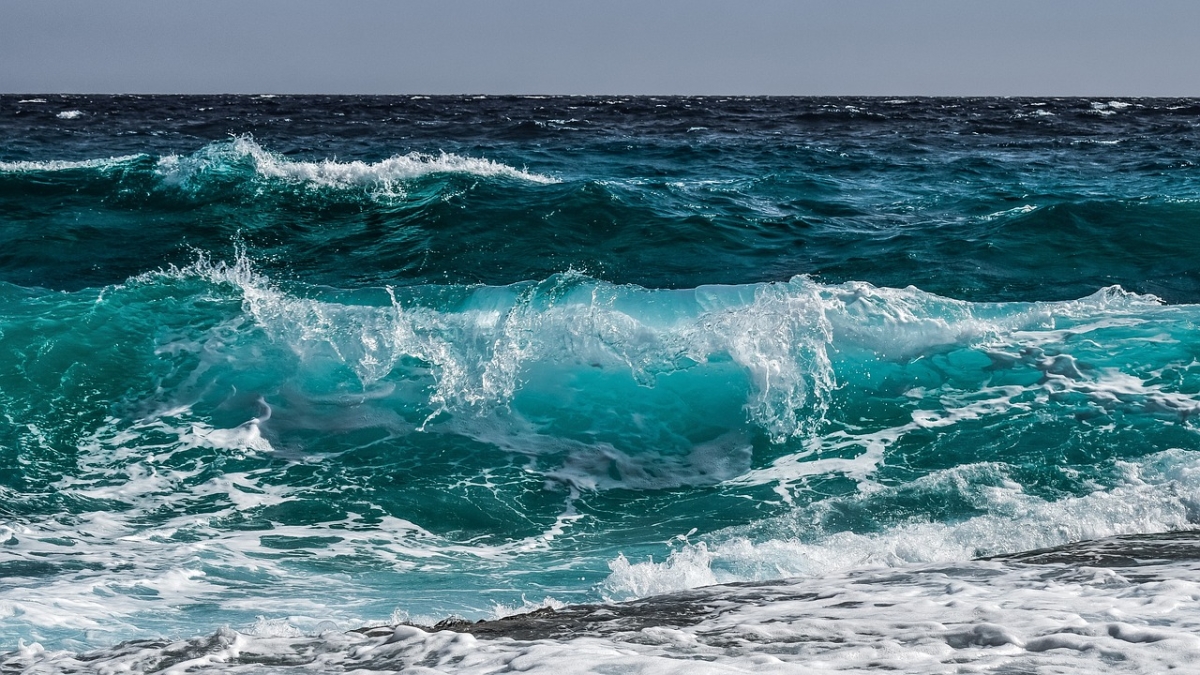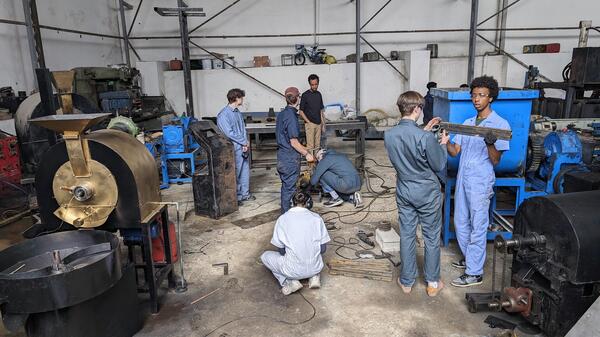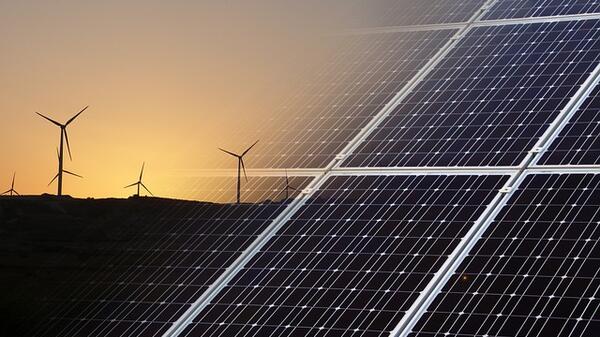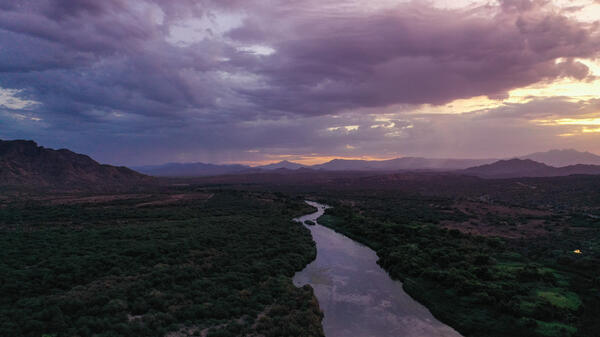ASU ocean scientists push for solutions beyond National Ocean Month

Photo courtesy Pixabay
As students and researchers at Arizona State University continue to expand our understanding of the ocean, they face challenges brought on by rising temperatures, acidification and harmful practices that put pressure on ocean systems. The month of June marks National Ocean Month, a time to reflect on the crucial role of Earth’s largest biome in our planetary systems.
Jesse Senko and Amy Maas, assistant professors in the School of Ocean Futures within the College of Global Futures, have a unique understanding of the ocean space. Senko, who is also an assistant professor at the School for the Future of Innovation in Society, works with coastal communities in the Pacific and Atlantic oceans to implement innovative approaches that protect sea turtles and other marine life while ensuring coastal livelihoods. Based out of Bermuda, Maas holds a joint appointment in the School of Life Sciences and studies the biogeochemical role of zooplankton in open ocean systems and the effects of climate change on these organisms.
As National Ocean Month comes to a close, Senko and Maas know they still have years of work to do. In a Q&A with ASU News, they reflect on their goals, barriers and solutions to ocean health, and the oceans' impact on waterfront communities and desert metro areas alike.
Editor's note: Answers have been edited for length and clarity.
Question: How did you first start working with oceans and marine life?
Senko: I started working with sea turtles in 2004 as an undergrad at the University of Connecticut, when I studied abroad in Mexico during my junior year. When I was a master's student at the University of Florida, I was tracking sea turtles for my thesis. Before I started this project, everyone had told me that in order to protect these animals, you have to know where they are. But over the course of my thesis, I ended up tracking almost every single turtle to their deaths because they would end up drowning in fishing nets. It was really difficult to see, and I realized then that no amount of biology alone was going to protect these animals.
One of my biggest “eureka” moments was when a fisherman actually brought me a live turtle that he had caught in his net. It had one of my tracking tags on it, so he traced it back to me. He could have sold it on the black market for several weeks' worth of income, but instead he brought it to me because he wanted to get involved with our project.
This sounds like a no-brainer now, but at the time, nobody was really working with fishers. I invited him to join me for a beer and we talked, and he became a part of our project. From then on, my eyes were really opened to the immense value of working with coastal communities to reduce bycatch.
Maas: I grew up in Ohio — not a lot of ocean there — with no specific plans of being a marine biologist. I always liked critters and asking questions, so that was my start. For my master’s degree, I just knew I wanted to work with animals and be close to Boston. I got into a master's program at the University of Rhode Island, I think mostly because I had taken a trip there for my bachelor’s degree and met a professor who had some really big oceans-related projects and needed lots of students.
I got involved, and within six months was being paid to do graduate research. That meant I was joining this professor on his research expeditions. I ended up working at McMurdo Station in Antarctica, and the work there really excited me. I was constantly learning new things and starting to think about how the work I was doing affects other groups of thinkers and people and cultures. I fell into this space kind of by luck — and thankfully for me, I was good at it.
In my work now, I have two things I focus on: I’m a marine biologist, which means I'm really interested in the animals in the ocean and how they are responding to their environment; how it changes their physiology; how much they breed; how much they eat; how much waste products they produce. My second focus is as a biological oceanographer, which is much more based in systems thinking and understanding the function that these specific critters play in the broader picture of the global ecosystem.
For both of these topics, I study a group of organisms called zooplankton, which exist in the space between the small “plant-like" animals in the ocean and the larger animal life we typically see in an aquarium or zoo. I ask questions like: How do the zooplankton survive in their community? What happens to them at an individual level, and how does that in turn affect their ecosystems?
Q: What are some of the most pressing challenges you address through your work?
Senko: I think the obvious challenge that applies to my work is bycatch, which is the accidental capture of nontarget species in fisheries and is a global problem. If you throw a dart at a map and you hit a coastal area, they're going to have fisheries, and those fisheries are going to have bycatch.
Unsustainable fishing practices mean that we are wreaking havoc on the ocean ecosystems. This is especially problematic for marine life like sharks or sea turtles, who have long life spans, take a long time to mature and have limited offspring. These animals cannot sustain being removed from their environments, and removing them causes all kinds of problems in their ecosystem given the unique and important ecological roles they play.
But this isn’t a one-sided problem: There is a human element here as well. There are entire coastal communities who rely on the ocean. Many of these communities who rely on the ocean for resources or their very livelihoods are marginalized and face challenges that come with low incomes. We have to create actionable solutions that support human well-being and life underwater. We have to think about how to create a world in which people can build a relationship with the ocean that is not only sustainable, but also supportive and just.
Maas: The open ocean can seem so alien to us that a lot of people who don’t work directly with it don't think about it much, or relate to it. Part of what I feel like my job is, is showing people what's out there. It can be hard to care about something if you’ve never seen it. But even without seeing it or fully understanding the ocean, we interact with it in all kinds of ways.
The ocean is at risk from a variety of different human-based activities. There's the warming of the ocean and the increasing acidity of the ocean, just to name two examples. We often think of the ocean as this untouched thing, but when you think about all of the different ways that humans interact with it, the ocean suddenly isn’t as untouched as we thought.
There are organisms that are really affected by us, like the zooplankton I study, even if we don’t know they exist. The basic research I do comes down to figuring out who is in the ocean, what they're doing in the ecosystem, and how what they're doing is being affected by these human pressures.
Q: Many people in the United States do not have regular access to the ocean — it can feel really removed from their daily lives. How would you explain the ocean–land connection, especially in areas like the desert that ASU calls home?
Senko: The ocean may not be visible from Arizona and other parts of the country, but it is tremendously important. Without the ocean, none of us would be here. We rely on the ocean for oxygen, food and climate regulation. Even though we're located in the desert, that does not mean that the ocean is unimportant, and it doesn't mean that we shouldn't care about it. Tempe, for example, would literally be uninhabitable without the ocean.
Protecting the ocean is especially important for a state like Arizona, and especially for a region like Phoenix, right? We're already pushing the margins of what's hospitable both in terms of temperature and water supply, and our ocean is incredibly important to maintaining both of those systems.
There is sometimes an attitude that caring about the ocean is a bonus, or like an extracurricular activity when we are thinking about overall planetary health. But conversations about protecting our ocean can’t start with “we should.” It needs to be a matter of “we absolutely need to.”
Maas: I’ll also say that nearly 80% of the physical items that people have in Arizona have crossed an ocean — so even down to the things we keep in our homes and use day to day. The ocean connects all of humanity.
Our ocean also acts as a sponge of sorts to absorb carbon dioxide. About 30% of the carbon dioxide that humans have put into the atmosphere is ending up in the oceans every year, and it's pulling that out of the atmosphere, keeping it from warming the planet even more. I know heat is something that Arizonans certainly relate to, and the ocean has a large role to play in keeping Arizona habitable.
Q: Is there anything you want people to know about our ocean, or about the work being done to care for it?
Senko: I would say that the threats facing our oceans are grave, but there are also very real solutions. I think that's what sets ASU apart — a lot of entities out there are good at identifying problems, which is important. But it is a different challenge entirely to develop solutions. The solutions space is where ASU really shines. It's not just that we can develop solutions; it's that we can develop both environmentally and socially responsible solutions. That idea is at the heart of my work.
That’s why I'm so excited to be a part of the School of Ocean Futures. I feel like it also speaks volumes, quite frankly, that ASU named the school the School of Ocean Futures and not just the “School of Ocean Sciences” or “School of Marine Biology.” We are bigger than that. The School of Ocean Futures is truly an interdisciplinary school, and that's how we need to look at these problems.
Maas: I would just encourage everyone to be hopeful and do what they can. You can be part of the solution even if you aren’t studying oceans. Our ocean faces really big challenges, but there is power in individual action regardless of how close you are to the ocean. We see a lot of “more, more, more” mentality in our society, but more doesn’t help our ecosystems. “More” doesn’t necessarily make people happier. There is a beautiful simplicity in doing more with less, and that attitude can really help our ecosystems.
It is really natural to feel stuck when you hear about the challenges our planet is facing. But we are not stuck. We are an incredibly inventive species. I feel like we are almost in the teenage phase of our species: We are coming into our power and we don’t know quite what to do with it. If we collectively decide we want better for ourselves and our planet, we can make that happen.
Q: How can students or other interested parties get involved with your work?
Senko: That’s easy: Take my introductory class! I teach Ocean Conservation in the fall semester, which gets you started and also acts as a prerequisite for my study abroad program. In the study abroad program, 20 of my students and I travel to my study sites in Baja California Sur, Mexico, and we interact directly with fishermen. We catch, tag and measure sea turtles; we swim with whale sharks and sea lions; and we interact with fishing communities. It's a really immersive and transformative experience. Students on this trip are literally participating in my research program and are at the heart of the solutions-making experience.
I think that that's a really great way to get involved, and I'm always excited to meet new students who are passionate about the ocean. I basically live for that trip to Mexico — I really pour my heart and soul into making that an amazing trip. We've run it for five years now, and it’s my favorite week of the year.
Maas: I teach a class at the School of Ocean Futures designed for anybody who wants to know more about the ocean. I teach that class remotely from Bermuda, and it is just a really great starting point for people of all study areas. I recognize that I fell into ocean sciences kind of accidentally, so I wanted to offer something that gives people a level of exposure and confidence in this area even if you don’t commit your career to it. You can also find me on Instagram, where I talk a little bit about being a scientist and a mom, and balancing that work–life dynamic.
More Environment and sustainability

Student engineers travel to Ethiopia this summer to help protect local wildlife
The jagged peaks in Ethiopia’s Simien Mountains National Park are home to the rare gelada monkey. It is the only place in the entire world where the endangered animals — nicknamed the “bleeding-heart…

Global Futures Laboratory at ASU joins DOE initiative to empower women in clean energy
The U.S. Department of Energy-led Clean Energy Education and Empowerment Initiative has announced that Arizona State University now joins the initiative as a partnering university. The Julie…

Computer modeling shows where Arizona's winter precipitation originates
The Sun Corridor in Arizona in the semi-arid Southwestern U.S. is a land of seemingly unlimited growth that is constantly colliding with physical constraints. It is mountainous but also home to a…